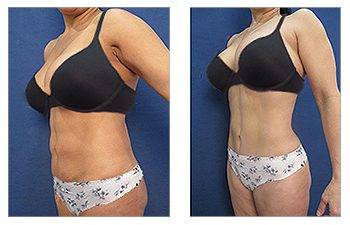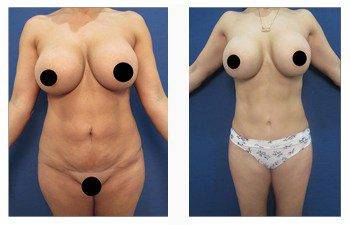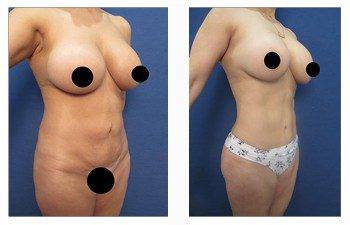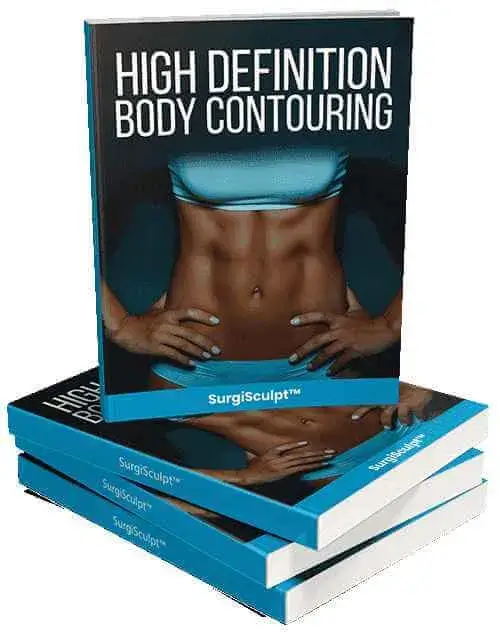
52-year-old female following a mini tummy tuck – front view

52-year-old female following a mini tummy tuck – front view

52-year-old female following a mini tummy tuck – left lateral view

52-year-old female following a mini tummy tuck – left oblique view

52-year-old female following a mini tummy tuck – front view

Download SurgiSculpt’s free Liposuction eBook
Introduction: Does Mini Tummy Tuck Tighten Muscles?
A mini tummy tuck does not tighten muscles. If a surgeon finds that your muscles have been pulled apart, it will be recommended to have a full tummy tuck with muscle repair. A mini tummy tuck does not grant a surgeon the ability to reach the upper and lower muscles. A mini tummy tuck reaches only the lower muscles, although if tightened, what results is what we call a “muffin top.” A muffin top can be described similarly to the appearance of a muffin, having a tighter bottom and a more inflated top. If a surgeon just tightens the lower belly, you will create a muffin top.
With muffin top deformities, revision tummy tucks are needed to revise and correct the inflated top. The revision tummy tuck is a full tummy tuck, providing the surgeon the ability to reach the upper and lower muscles and provide appropriate muscle repair, tightening both the top and bottom to smoothen out the abdomen.
If you are recommended a mini tummy tuck, this does not entail tightening the muscles. If a man or woman is in need of muscle repair, your surgeon should explain that this must be done with a full tummy tuck and that a mini tummy tuck does not entail the tightening of muscles for the reasons of the unwanted muffin top.
We are always in favor of patients who have done their research and have found the surgeon that best communicates the expectations and information about any procedure to their patients, as well as has many photos to support the beautiful results that the surgeon provides.
A mini tummy tuck is a popular cosmetic procedure for those looking to improve the appearance of their lower abdomen. However, it is important to note that a mini tummy tuck does not address the muscles of the abdomen. This means it does not provide the same level of muscle tightening as a full tummy tuck. For patients who have weakened or separated muscles, a full tummy tuck is necessary for muscle repair.
Choosing to only tighten the lower belly with a mini tummy tuck can result in a “muffin top” appearance, where there is excess skin and fat above the tightened area. To correct this, a revision tummy tuck may be needed to provide a more comprehensive and balanced result.
Dr. Moein is an expert in offering the mini tummy tuck procedure and is well-versed in the benefits it provides for patients. With his extensive experience and skill, Dr. Moein is able to effectively address the specific needs and goals of each patient, ensuring a satisfying outcome.
In conclusion, while a mini tummy tuck can provide improvements in the lower abdomen, it is important to consider the necessity of muscle repair and potential issues that may arise. Dr. Moein is dedicated to providing exceptional care and results for patients seeking a mini tummy tuck procedure.
What is the difference between a full tummy tuck and a mini tummy tuck?
A full tummy tuck and a mini tummy tuck differ in several key aspects. In a full tummy tuck, the entire abdominal area is targeted, including both the upper and lower abdomen. This procedure also includes the repair of the abdominal muscles, which may have become stretched or separated due to pregnancy or weight fluctuations. The incision size for a full tummy tuck is typically larger, running from hip to hip, allowing for more extensive removal of excess skin and tissue. Liposuction is often used in conjunction with a full tummy tuck to further contour the area and remove stubborn pockets of fat.
On the other hand, a mini tummy tuck focuses primarily on the lower abdominal area below the navel. It is generally less invasive than a full tummy tuck and may not always involve muscle repair. The incision size for a mini tummy tuck is smaller and is typically limited to the lower abdomen. Liposuction may still be used to achieve a more sculpted look but to a lesser extent than in a full tummy tuck. These differences between the two procedures allow for a more tailored approach based on the patient’s specific needs and goals.
Benefits of Mini Tummy Tuck
A mini tummy tuck, also known as a partial abdominoplasty, is a surgical procedure that targets the lower abdomen to remove excess skin and fat and tighten the muscles. This less invasive alternative to a full tummy tuck offers several benefits, making it a popular choice for individuals looking to achieve a slimmer and more toned abdominal area. Some of the key advantages of a mini tummy tuck include minimal scarring, quicker recovery time, and less discomfort compared to a traditional tummy tuck. In addition, this procedure can help improve the appearance of the lower abdomen, especially for individuals who have experienced weight loss or pregnancy. By understanding the benefits of a mini tummy tuck, individuals can make an informed decision about whether this procedure is the right option for achieving their desired aesthetic goals.
Shorter Incisions
In a mini tummy tuck, the use of shorter incisions offers several benefits. One of the primary advantages is the minimal scarring that results from the procedure. With shorter incisions, the risk of noticeable scarring around the belly button is significantly reduced. This is especially beneficial for those who are concerned about the aesthetic appearance of their abdomen post-surgery.
Furthermore, the use of shorter incisions can be advantageous for individuals with only a small amount of skin laxity in the lower belly. By targeting specific areas of concern with precision, the procedure can effectively address minor issues without the need for extensive incisions. This not only minimizes scarring but also promotes a faster recovery time for the patient.
Overall, the use of shorter incisions in a mini tummy tuck offers a more discreet and aesthetically pleasing outcome, particularly for those with small skin laxity in the lower belly. It allows for a targeted approach to address specific concerns while minimizing the risk of visible scarring, ultimately resulting in a more satisfying and natural-looking outcome.
Shorter Surgery
A traditional tummy tuck typically requires general anesthesia and can last 2-5 hours, while a mini tummy tuck is usually performed under local anesthesia with IV sedation and takes around 1-2 hours. The reduced surgical time for a mini tummy tuck is attributed to the smaller incision size and the focused target area of the lower abdomen, as compared to the more extensive work involved in a traditional tummy tuck.
The key factors contributing to the shorter duration of a mini tummy tuck include the use of local anesthesia with IV sedation, which eliminates the need for full general anesthesia, as well as the limited size of the incision. These factors result in a quicker and less complex procedure.
The benefits of a shorter surgery for patients undergoing a mini tummy tuck are numerous. These include a reduced risk of scarring due to the smaller incision, as well as a quicker recovery time. Additionally, the use of local anesthesia with IV sedation minimizes the potential risks and side effects associated with general anesthesia. Overall, a shorter surgery for a mini tummy tuck offers patients a more efficient and potentially less invasive option for achieving their desired results.
Reduced Recovery Time
After undergoing a mini tummy tuck procedure, it is important to follow specific steps to reduce recovery time and ensure proper healing. One key step is to wear an abdominal support accessory or garment for 3 to 6 months, as recommended by your surgeon. This will provide support to the surgical area and aid in the healing process.
Additionally, it is crucial to avoid strenuous activities for at least 6 weeks to prevent complications and allow the body to properly recover. Following all instructions given by your surgeon for proper care, including how to care for drain and incision tubes, is also essential. This may involve keeping the incision and drain sites clean and dry, as well as monitoring for any signs of infection.
To prevent infection and maintain overall health during the recovery period, it is important to follow a balanced diet, stay hydrated, and get plenty of rest. It is also crucial to follow up with your plastic surgeon as scheduled to monitor your progress and address any concerns.
By following these instructions and taking proper care of the surgical site, patients can help to minimize recovery time and achieve satisfactory results after a mini tummy tuck.
Disadvantage of Mini Tummy Tuck
When considering a mini tummy tuck, it’s important to be aware of the potential disadvantages that come with this procedure. Despite the many benefits it offers, such as a shorter recovery time and smaller incisions, there are certain drawbacks to consider. Understanding these disadvantages can help you make an informed decision about whether a mini tummy tuck is the right choice for you.
No Muscle Plication
Muscle plication is possible for this procedure because of the limited undermining. By omitting muscle plication, it is not possible to correct your abdominal contour if you have loosened muscles. This is likely the most critical factor when trying to decide between undergoing a mini versus full tummy tuck.
No elimination of upper abdominal skin redundancy
Upper abdominal skin redundancy can pose challenges and limitations if not eliminated, including potential physical discomfort and hygiene issues. Unfortunately, this skin cannot be eliminated with a mini tummy tuck. The excess skin can lead to chafing, irritation, and discomfort, especially during physical activities. It can also create difficulties in maintaining proper hygiene, as the folds of the skin can trap moisture and bacteria, leading to potential skin infections.
There are alternative options for managing excess skin without undergoing surgical procedures. Non-invasive body contouring treatments, such as laser therapy or radiofrequency treatments, can help tighten and tone the skin without the need for surgery. These treatments can help reduce the appearance of excess skin and improve overall body contour. Additionally, custom-fit compression garments can provide support and compression to the abdominal area, helping to minimize the appearance of redundant skin and provide added comfort.
Overall, addressing upper abdominal skin redundancy is important not only for physical discomfort and hygiene but also for overall confidence and well-being. Considering non-invasive treatments and compression garments can offer viable alternatives to surgical intervention.
Lowering of Belly Button
During a mini tummy tuck procedure, the belly button is automatically lowered due to the design of this surgery. Fortunately, it is only lowered by a few centimeters. The extent of lowering can be even more dramatic in patients choosing to undergo a floating belly button technique that is used when the belly button is actually too high preoperatively.
It is crucial to discuss these options with a board-certified cosmetic or plastic surgeon to determine the best method for achieving a natural-looking result that aligns with your aesthetic goals. Your surgeon will be able to assess your individual anatomy and discuss the most appropriate technique for achieving a satisfactory outcome. By collaborating with a qualified professional, you can ensure that your mini tummy tuck addresses your specific concerns and delivers a natural and harmonious result.
In conclusion, when considering a mini tummy tuck, the options for lowering the belly button, such as floating the belly button or using a standard umbilical incision for aesthetic refining, should be carefully evaluated with the guidance of a board-certified plastic surgeon to achieve the most favorable outcome.
Who Is Eligible For A Mini Tummy Tuck?
Eligibility for a mini tummy tuck is determined by specific criteria. Ideal candidates for this procedure are individuals who are in good physical health, with a relatively small amount of excess skin and fat in the lower abdominal area. They may have localized areas of loose skin or a small pooch below the belly button that they want to address. Additionally, it is not feasible to tighten the muscles when performing a mini tummy tuck.
A full tummy tuck, on the other hand, is more suitable for individuals with a larger amount of loose skin and fat in the entire abdominal area, including above and below the belly button. Those with significant weight loss or multiple pregnancies may benefit more from a full tummy tuck.
Key factors that determine candidacy for a mini tummy tuck include physical health, the amount of excess skin and fat in the lower abdomen, and the overall body type of the individual. Those who are not suitable candidates for a mini tummy tuck may include individuals with a significant amount of excess skin and fat, those with major health concerns, and those who are not committed to maintaining a healthy lifestyle post-procedure.
In conclusion, the eligibility for a mini tummy tuck is dependent on individual factors such as physical health, amount of excess skin, and overall body type. This procedure may be suitable for those with localized areas of loose skin and fat in the lower abdomen, but not for those with more extensive concerns in the entire abdominal area.
Conclusion: Does mini tummy tuck tighten muscles?
A mini tummy tuck can provide some muscle tightening in the lower abdomen, but it has limitations in reaching and tightening the upper muscles. For more comprehensive muscle repair, a full tummy tuck may be necessary. The criteria for muscle tightening often involves the presence of loose or separated abdominal muscles, which can result in the “muffin top” deformity. To address this, a full tummy tuck is recommended as it allows for the repair and tightening of both upper and lower abdominal muscles. While a mini tummy tuck can be effective for addressing localized areas of excess skin or fat, it may not be the best option for those seeking significant muscle tightening or repair. Therefore, it’s important to carefully consider the specific needs and goals of the individual when determining the most suitable procedure.
Please see this 52-year-old female 3 months following a mini tummy tuck. This patient demonstrates the transformation of her body appearance.
